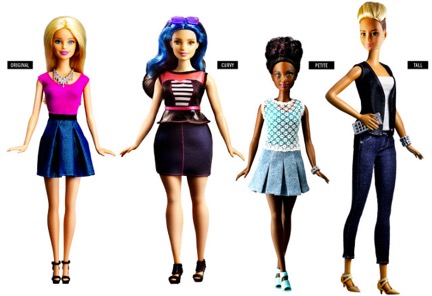by Tracy de Boer
When I first heard that Barbie was coming out with three new body types (petite, tall and curvy in addition to the original doll’s proportions), I was torn.
On the one hand, I wanted to commend Mattel’s adaptiveness and dare I say, progressiveness (or maybe “progressive-lite” is more accurate). What is especially interesting is the release of the “curvy” bodied doll, whose shape is the furthest departure from the traditional figure, and whose body type doesn’t fit original Barbie’s clothes. On the other hand, I feel as if capitalism has co-opted feminism for its own gains. This comes in the wake of other semi-feminist advertising campaigns such as CoverGirl’s #GirlsCan Campaign or Dove’s Campaign for Real Beauty. “Oh great,” I think to myself, “Now companies are using feminism to sell make up and Barbies to women?” How ironic.
I’ll admit that when we were growing up, my sister and I had a lot of Barbies. She was the star of our playtime: we would dress and undress her, take her on adventures, cut her hair, colour on her with permanent markers, remove her limbs and use them as utensils—you know, girl stuff.
My mother later tells me that she had struggled over whether to let my sister and I have Barbies at all. While she wouldn’t have said her reasons were overtly feminist (as the label was perhaps a bit more controversial to her demographic than it is for mine), I think that some idea of female independence or empowerment permeated my sister’s and my childhood.
While we were allowed to play with Barbie, our selection of toys (and books, movies and choice of activities) was intentionally diverse. In addition to Barbie and all her accessories, we also had Hot Wheels, Lego (and not the girl’s Lego sets either), My Little Ponies, Supersoaker water guns, Beanie Babies, and probably whatever else was cool in the 90’s. However, there were some toys that were definitely never allowed into our home. Namely, the Easy-Bake Oven. Apparently the Easy-Bake Oven was considered a little too old fashioned for our mother’s tastes. Instead, my sister and I got the Creepy Crawler Bug Maker machine. It’s basically like an Easy-Bake Oven, except you bake liquid (“Plastigoop”) into rubbery spiders and worms. And then, there is the added step (not advertised) of hiding the finished products in people’s shoes (as my sister and I often did).
But things have since changed. I notice it most when I visit my cousin’s kids: the gendered division between toys, clothes, bedroom décor, TV shows, proper behaviour, etc. Apparently, toys are more divided by gender now than they were prior to the 1990’s. For instance, blue toolboxes, trucks, and building sets for boys, pink kitchen sets, dolls, and everything princess for girls. What’s more, some toy makers, like Lego, now release building sets catered specifically to girls (in more “feminine colours”) that are meant to create things like grocery stores or dollhouses—which seem to reinforce gender stereotypes. (Lego pirate ships for boys, Lego grocery stores for girls.)
As Maria Montessori has stated, “Play is the work of the child.” In other words, it is through play that children learn about the options and activities available to and appropriate for them. Feminists have argued that gender socialization begins extremely early and continues to shape children’s identities through play activities.
But this (recent) extreme segregation between boy’s and girl’s toys has not been met without pushback. Companies like Target have recently decided to eliminate “boys” and “girls” signs from toy and bedding departments, and The Gap recently launched gender-neutral infant and children’s clothing lines. These efforts are intended to reduce the force of gender stereotyping—especially for those of such a young age. The idea is that, regardless of gender, we ought to be able to decide what careers, activities, and lives we would like to pursue. In fact, this is the focus of Dr. Cordelia Fine’s current research and the topic of her talk, “Let Toys Be Toys: The Science and Ethics of Gendered Toy Marketing,” which will be on Tuesday March 8th at 7:00pm at the Wolf Performance Hall.
So perhaps Mattel’s release of Barbie’s new body types is timely. While we may have reason to be suspicious that the new Barbie bodies is nothing more than a marketing ploy (Barbie sales had dropped 20% between 2012 and 2014), the fact that the company decided that embracing a kind of diversity was their best bet at success is certainly interesting. Optimistically, I think changes like this might actually signify a positive and more inclusive shift in social values. Personally, I’m looking forward to the release of a “Dad Bod Ken.”
In closing, here is a cute video of children reviewing the new Barbie bodies.
Pictured above: Original, curvy, petite and tall Barbie. Photo courtesy of Geekologie.






